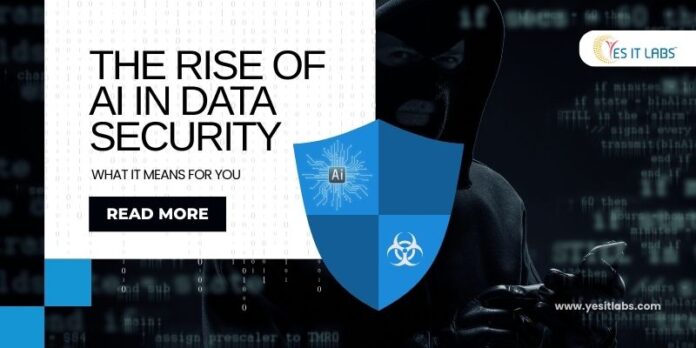Artificial Intelligence (AI) is no longer a distant future concept. It is here, transforming industries, automating workflows, and redefining how we protect valuable data. As cyberattacks grow more sophisticated, the role of AI in cybersecurity has moved from optional to essential. For individuals, businesses, and enterprises alike, understanding how AI enhances data security is becoming increasingly important.
In this article, you will discover why AI is becoming the backbone of cybersecurity, the benefits and risks, real-world applications, and what these changes mean for you.
Why AI Is Becoming Essential in Data Security
Cybersecurity threats are growing at a speed humans alone cannot manage. According to IBM’s 2024 Cyber Security Report:
- Cyberattacks increased by 38 percent globally in the last year
- The average data breach cost reached 4.45 million dollars
- Human error contributes to 95 percent of breaches
AI solves the challenge of scale and speed. Modern systems generate massive amounts of data, logs, and behavior patterns. AI can process this information in real time, something human analysts or traditional tools cannot handle efficiently.
How AI Strengthens Data Security
1. Real-Time Threat Detection
AI quickly identifies suspicious events such as abnormal login attempts, unexpected file access, or unusual network behavior. This reduces detection time from weeks to seconds and dramatically improves incident awareness.
2. Predictive Analytics
Predictive AI models analyze historical trends and emerging threat behavior. They can highlight:
- Outdated applications vulnerable to attacks
- Login anomalies that resemble previous intrusions
- Behavior deviations that may indicate insider threats
This proactive approach helps businesses stay ahead of vulnerabilities before they escalate.
3. Automated Incident Response
AI-driven systems can take action instantly when a threat is detected. They can:
- Isolate infected devices
- Block malicious traffic
- Disable compromised accounts
This reduces the impact of attacks and prevents lateral movement across networks.
4. Enhanced Authentication and Zero Trust
AI improves user verification through adaptive authentication and behavioral biometrics like typing cadence or device usage habits. Zero Trust models now used by more than 60 percent of enterprises rely heavily on AI to evaluate users and devices continuously.
Real-World Applications of AI in Cybersecurity
Cloud Security
Cloud platforms such as AWS, Google Cloud, and Azure use AI to monitor massive volumes of events in real time and flag anomalies as they arise. Many businesses rely on AWS freelancers to help configure secure cloud environments that integrate seamlessly with AI-based detection tools.
Email Threat Prevention
Phishing remains responsible for 90 percent of cyberattacks. AI analyzes email patterns and context to filter advanced phishing attempts that traditional tools fail to detect.
Fraud Detection
Financial institutions rely on AI to identify fraudulent transactions within milliseconds. For example, Mastercard uses AI to review over 75 billion transactions annually, helping reduce false declines and fraud losses.
Endpoint Security
AI adds strong protection to personal devices, IoT sensors, laptops, and servers. It identifies malware by behavior, not just signatures, making it effective even against new and unknown threats.
AI’s Limitations and Risks
AI improves security significantly but introduces new challenges as well.
1. AI-Enhanced Cyberattacks
Cybercriminals now use AI to generate convincing phishing messages, craft deepfake audio, and automate complex attacks. As a result, organizations increasingly hire MySQL developers to secure their backend systems and ensure proper database protection against evolving AI-powered threats.
2. False Positives
AI can mistakenly flag normal actions as threats, which may disrupt business operations or lead to unnecessary account lockdowns.
3. Data Privacy Concerns
Training AI models requires large datasets, raising concerns such as:
- Data ownership
- How securely training sets are stored
- Whether personal information might be exposed
4. Over-Reliance on AI
AI systems require proper oversight. Skilled cybersecurity analysts must still review incidents, optimize strategies, and make decisions based on human judgment.
What This Means for You
For Individuals
AI-based security protects your:
- Online accounts
- Banking information
- Social media profiles
- Personal identity
- Shopping data
Most modern features, such as biometric verification, Google security alerts, and fraud notifications, work quietly using AI in the background.
What you should do:
- Enable multi-factor authentication
- Use strong and unique passwords
- Update your devices regularly
- Avoid unknown attachments and links
- Check your accounts for unusual activity
For Businesses
As threats evolve, businesses benefit greatly from adopting AI-driven protection. Companies using AI security tools can:
- Reduce breach costs by up to 65 percent
- Improve response time
- Strengthen compliance
- Protect customer trust
Investing in Ai software development services can help companies integrate custom detection systems, automate responses, and secure their digital infrastructure more effectively.
Key steps for businesses:
- Use AI-based endpoint protection
- Train teams on phishing and social engineering
- Adopt AI-driven access management
- Monitor cloud environments continuously
- Implement predictive analytics tools
The Future of Cybersecurity With AI
AI is shaping the next era of cybersecurity. In the coming years, experts predict:
- Nearly 90 percent of cybersecurity tools will rely on AI
- Passwordless authentication will become standard
- Autonomous incident response systems will grow
- AI will enforce stronger compliance and privacy controls
Staying informed and adopting AI-driven solutions early will help individuals and organizations remain secure in a rapidly changing digital environment.
Final Thoughts
The rise of AI in data security provides powerful ways to defend against evolving cyber threats. While it does introduce challenges such as privacy concerns and the risk of AI-generated attacks, the benefits far outweigh the drawbacks. For individuals, it offers safer digital experiences. For businesses, it ensures stronger defense, proactive monitoring, and faster response.
